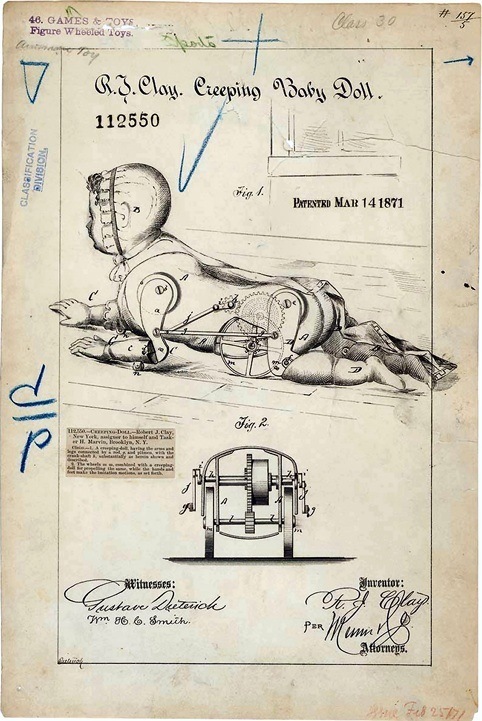Creeping Baby Doll Patent

Annotation
Strongly influencing the invention of Robert J. Clay's mechanized "Creeping Baby Doll" in 1871, were changing notions of childhood that fostered children's development.
Allowing babies to crawl on all fours as did Clay's doll reflected recent changes in childrearing practices. In Early Modern Europe and in early America, the association between crawling babies and the insane and animals, led parents to require babies to stand and walk as soon as they were able. Greater understanding of children's development by the early 19th century led parents to stash the seat-less "standing stool" that had been used for generations. Although in 1835, Amira Phelps, a mother and a female educator, asserted in her diary that she would not let her son "learn to creep," by the time he was able to she accepted crawling as "nature's way."
As notions of childhood continued to change in the years after the Civil War, American men like Robert J. Clay applied their ingenuity to the invention of toys and the development of an American industry. Competing against the Europeans whose dolls flooded the American market, male inventor/businessmen applied machine technology to doll designs. Rather than patent the entire doll as Clay did, most inventors patented a single device (e.g., joints).
Although Clay claimed in his patent that the Creeping Baby Doll would be a "very amusing toy," mechanical dolls disturbed more than delighted consumers. Enoch Rice Morrison's top heavy "Autoperipatetikos" dolls often fell flat on their faces and Edison's "Talking Dolls" had speech problems. Seeking to improve upon Clay's prototype, his employer, Robert Pemberton Clarke, patented an "Improved Creeping Baby Doll."
Patent drawings and descriptions of inventions provide more than just technical information: these sources are useful for understanding the construction of dolls and childhood.
Credits
"A creeping baby doll," The National Archives Experience Digital Vaults (accessed October 24, 2009). Annotation by Miriam Forman-Brunell.